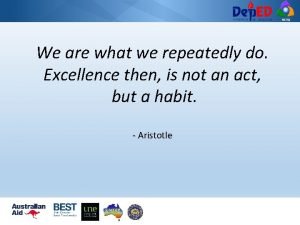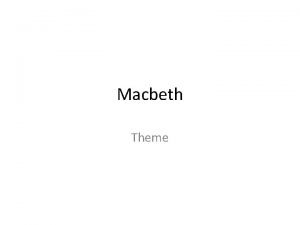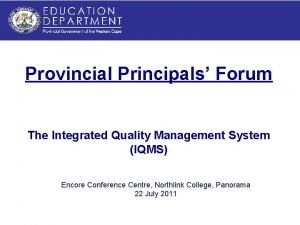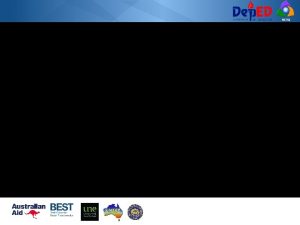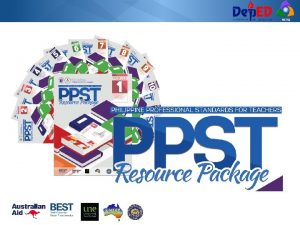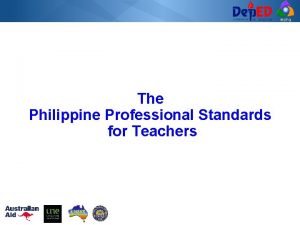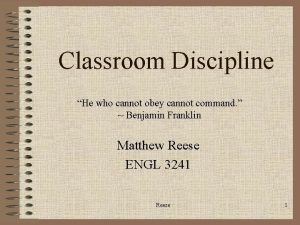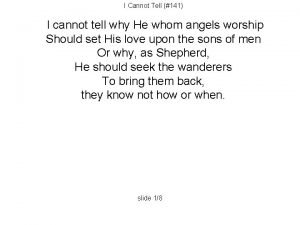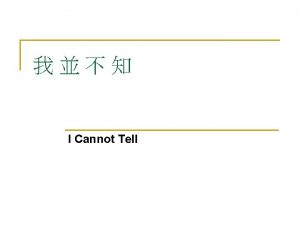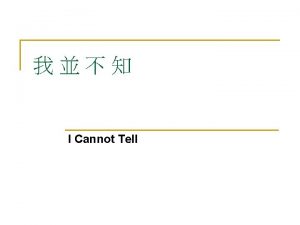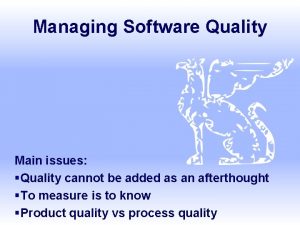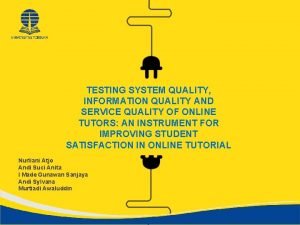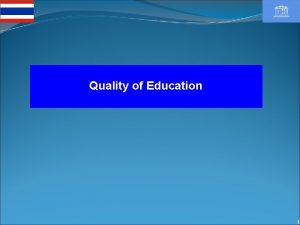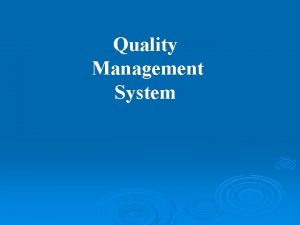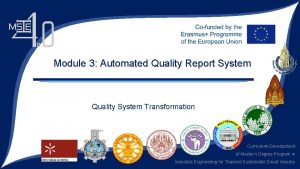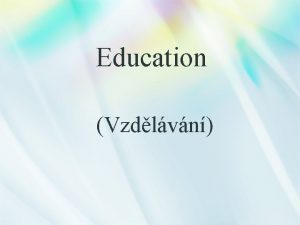RCTQ The quality of an education system cannot








































- Slides: 40

RCTQ “The quality of an education system cannot exceed the quality of its teachers. ” (Mc. Kinsey and Co. , 2007)

RCTQ Classroom Observation Tool - RPMS

RCTQ What is Classroom Observation? • One gauge in ensuring quality teaching - RA 10533 (K to 12 Law) • A process of providing feedback to a teacher’s classroom practice • Encourages teachers to reflect and develop self-awareness about their own practice • Provides evidence of actual teacher performance, their strengths and areas of improvement - RPMS Manual (2018)

RCTQ Rationale for the Development of the Standardsbased Classroom Observation Tool PPST Teacher Quality Requirement COT of K to 12 Classroom Practice Professional Development

RCTQ The new Classroom Observation Tool (COT) is based on the Philippine Professional Standards for Teachers (PPST)

RCTQ What is the Philippine Professional Standards for Teachers (PPST)? • Is a public statement of professional accountability • It has four career stages: Beginning, Proficient, Highly Proficient, and Distinguished. • It has seven Domains, 37 Strands, and 37 Indicators for each career stage.

RCTQ Classroom Observable Strands of the Philippine Professional Standards for Teachers 21 out of 37 strands are classroom observable Domain 1 Domain 2 Domain 3 Domain 4 Domain 5 Domain 6 Domain 7 1. 1 2. 1 3. 1 4. 1 5. 1 6. 1 7. 1 1. 2 2. 2 3. 2 4. 2 5. 2 6. 2 7. 2 1. 3 2. 3 3. 3 4. 3 5. 3 6. 3 7. 3 1. 4 2. 4 3. 4 4. 4 5. 4 6. 4 7. 4 1. 5 2. 5 3. 5 4. 5 5. 5 1. 6 2. 6 1. 7 7. 5

RCTQ There are 12 priority strands (out of 37) chosen by Dep. ED for 2018 Of these twelve (12), nine (9) are classroom observable for Proficient teachers (Teacher I-III) while there are five (5) for Highly Proficient (Master Teacher I-IV)

RCTQ How does the COT address the continuum of practice?

RCTQ 1 2 3 4 5 6 7 8 9 Beginning Not Evident Building Organizing Developing Applying Proficient Consolidating Integrating Highly Proficient Discriminating Distinguished Synthesizing

RCTQ INDICATOR 1 Applies knowledge of content within and across curriculum teaching areas knowledge of content within andand across curriculum teaching areas INDICATOR 1 Applies knowledge of content within across curriculum teaching areas 4 7 43 65 76 7 8 1 2 3 5 4 5 6 8 9 Theteacher The teacher. The applies The teacher teacher applies The applies demonstrates demonstrates applies highapplies demonstrates minor demonstrates high-level knowledge substantial moderate minor content accurate and in accurate, inlevel exceptional content errors eithererrors in accurate knowledge of accurate, accurate and in-depth accurate, in-depth and accurate knowledge of and in-depth and of content and of andknowledge of content within and content errors either in in-depth knowledge of -depth and knowledge of the presentation of the keytheconcepts both knowledge of of most broad knowledge of allcontent pedagogy that creates either in the related to lessonknowledge presentation keyin concepts knowledge content withincurriculum content within key concepts both in of most broad knowledge ofbroad all pedagogy that and creates across presentation of concepts either of the lesson or both in the most concepts knowledge of all pedagogy that and across lesson or in responding the presentation the conceptsininthe concepts in the a conducive learning the presentation of the concepts in the of concepts a conducive learning curriculum content areas to the lesson or in in the in responding to presentation of in the concepts in the creates a curriculum to students’ questions orof presentation lesson and inof thethe lesson and presentation of of the presentation of the environment that areas lesson and environment that empower to to responding to in presentation students’ in presentation of conducive content areas to students content comments. to The responding to students’ lessontheand in the lesson in enables and an in-depth students’ thelesson or in lesson questions responding to lesson and in and learning develop responding students’ andorin enables an in-depth andempower acquire apply and questions responding to questions comments. or. The students’ responding to environment that students to students contentordisplays responding to students’ sophisticated questions or comments. responding tocomments. students’ responding to students’ sophisticated successful learning comments. students’ lesson content questions or students’ enables an inacquire and lifelong simple coherence. The lesson questions in aand manner understanding of the The lesson content questions in content a manner questions in ainmanner understanding of the apply strategies to assist in questions or displays simple comments. The questions a questions in a depth learning skills. displays coherence. that is attempts that to successful teaching and learning comments. The that coherence. lesson content manner thatto betomanner teaching that isis responsive sophisticated displays coherence. attempts to be responsive and learning their development as lesson content The teacher attempts displays responsive attemptsto to student be responsive to understanding of learning student to developmental process to meet The teacher attempts responsive to student developmental process meet independent learners. does not coherence. The responsive to student the teaching and strategies to to make connections developmental learning needs and assist individual or group to make connections developmental learning needs anddevelopmental individual or group display teacher student process in their across curriculum learning needs. Thelearning promotes student learning coherence attempts topromotes developmental needs toneeds meet as needs within across curriculum learning needs. The student within development learning and promotes individual or independent contentmakes areas if make teacher makes learning. The teacher and across curriculum content areas if teacher learning. Theneeds. teacher and across curriculum connections The teacher student group learning learners. appropriate. across connections acrosslearning. content makes meaningful content areas. appropriate. connections makes meaningful areas. across makes The needs within curriculum contents across curriculum connections makes and across curriculum contents across teacher connection content areas if across meaningful curriculum areas if appropriate. curriculum content appropriate. curriculum connection content areascontents if appropriate. areas across areas if appropriate. TEACHER I-III (PROFICIENT) if appropriate. curriculum content areas if appropriate. MASTER TEACHER I-IV (HIGHLY PROFICIENT)

RCTQ Classroom Observation Tool - RPMS

RCTQ How is COT-RPMS used in the RPMS cycle?

Mapped COT Indicators Indicator to Mapped to. RPMSObjectives RCTQ COT INDICATOR NO. 1 1 2 3 2 4 3 5 6 4 7 8 5 9 COT-RPMS INDICATORS (HIGHLY PROFICIENT) COT-RPMS INDICATORS (PROFICIENT) Applies knowledge of content within and across curriculum teaching areas Applies knowledge of content within and across curriculum Uses a range of teaching strategies that enhance learner achievement in teaching areas literacy and numeracy skills Appliesa range of teaching strategies develop critical and Applies of teaching strategies to developtocritical and creative thinking, well as other thinking skills creativeasthinking, as higher-order well as other higher-order thinking skills Manages classroom structure to engage learners, individually or in groups, in meaningful exploration, discovery and hands-on activities within a range Manages classroom structure to engage learners, of physical learning environments individually or behavior in groups, in meaningful exploration, Manages learner constructively by applying positive and nonviolent discipline ensure learning-focused environments discovery andtohands-on activities within a range of physical Uses differentiated, developmentally appropriate learning experiences to learning environments address learners' gender, needs, strengths, interests and experiences Manages learner behavior constructively by applying Plans, manages and implements developmentally sequenced teaching and positiveprocesses and non-violent discipline to ensure learning to meet curriculum requirements andlearningvaried teaching contexts focused environments Selects, develops, organizes, and uses strategies appropriate teaching Develops and applies effective in the and learning resources, including ICT, to address learning goals planning and management of developmentally Designs, selects, organizes, and uses diagnostic, formative and summative sequencedstrategies teaching and learning process to meet assessment consistent with curriculum requirements RPMS OBJECTIVE NO. 1 1 2 33 4 45 6 57 9 7 10

RCTQ The results of classroom observation are considered nonnegotiable means of verification (MOV) of teacher performance that can prove teacher’s attainment of classroom observable objectives in the RPMS Tools. COT-RPMS TEACHER I-III INTER-OBSERVER AGREEMENT FORM OBSERVER 1: __________________ OBSERVER 2: __________________ OBSERVER 3: __________________ DATE: _____________________ OBSERVATION 1 2 3 NAME OF THE TEACHER OBSERVED: __________________ SUBJECT & GRADE LEVEL TAUGHT _______________ 4 DIRECTIONS FOR THE OBSERVER: 1. Indicate your individual rating for each indicator. 2. Discuss within the group your reason/s for such rating. In case of different ratings, the observers must resolve the difference and come up with an agreed rating. The final rating is not an average ; it is a final rating based on reasoned and consensual judgment. 3. Attach all individual Rating Sheets to the Inter-Observer Agreement Form. THE TEACHER: Observer 1 Observer 2 Observer 3 AGREED RATING 1. Applies knowledge of content within and across curriculum teaching areas 5 7 6 6 2. Uses a range of teaching strategies that enhance learner achievement in literacy and numeracy skills 5 5 Applies a range of teaching strategies to develop critical and creative thinking, as well as other higher-order thinking skills 4. Manages classroom structure to engage learners, individually or in groups, in meaningful exploration, discovery and hands-on activities within a range of physical learning environments 5. Manages learner behavior constructively by applying positive and non-violent discipline to ensure learning-focused environments 5 6 6 6 6 7 6 5 6 Uses differentiated, developmentally appropriate learning experiences to address learners' gender, needs, strengths, interests and experiences 6 7 7 6 Plans, manages and implements developmentally sequenced teaching and learning processes to meet curriculum requirements and varied teaching contexts 6 6 8. Selects, develops, organizes, and uses appropriate teaching and learning resources, including ICT, to address learning goals 6 5 7 6 9. Designs, selects, organizes, and uses diagnostic, formative and summative assessment strategies consistent with curriculum requirements 7 6 5 7 3. 6. 7.

RCTQ Which indicators will be observed during observation?

INDICATOR LIST FORFOR HIGHLY PROFICIENT COT NO. INDICATOR NO. 1 2 3 4 5 6 7 8 9 INDICATORS INDICATOR DESCRIPTION Applies knowledge of content within and across curriculum teaching areas of content withinlearner and achievement across Uses a. Applies range of knowledge teaching strategies that enhance in literacycurriculum and numeracy skills teaching areas Applies a range of teaching strategies to develop critical and Applies a range of teaching strategies to develop creative thinking, as well as other higher-order thinking skills critical and creative as wellindividually as otherorhigher. Manages classroom structure tothinking, engage learners, in thinkingexploration, skills discovery and hands-on activities within groups, order in meaningful a range of physicalclassroom learning environments Manages structure to engage learners, Manages learner behavior constructively by applying positive individually or in groups, in meaningful exploration, and non-violent discipline to ensure learning-focused environments discovery and hands-on appropriate activities within Uses differentiated, developmentally learninga range of experiences to address learners' gender, needs, strengths, interests and physical learning environments experiences Manages learner behavior constructively by applying Plans, manages and implements developmentally sequenced positive and non-violent discipline to ensure learningteaching and learning processes to meet curriculum requirements and varied focused teaching contexts environments Selects, develops, organizes, and uses appropriate teaching and learning Develops and applies effective strategies in the resources, including ICT, to address learning goals planning and management of developmentally Designs, selects, organizes, and uses diagnostic, formative and sequenced teaching and learning meet summative assessment strategies consistent withprocess curriculumtorequirements OBSERVATION PERIOD 1 2 3 4 1 2 3 RCTQ 4 1 2 3 4 5 curriculum requirements and varied teaching contexts q Indicators to be observed per observation period are highlighted in yellow

RCTQ What are the steps in conducting observation?

PRE- OBSERVATION STEP 1 - OBSERVER 1. Review the appropriate COT-RPMS rubric for the teacher to be observed. COTRPMS Rubric RCTQ INDICATOR 1 Applies knowledge of content within and across curriculum content teaching areas 3 4 5 6 7 The teacher demonstrates minor content errors either in the presentation of the lesson or in responding to students’ questions or comments. The lesson content displays simple coherence. The teacher demonstrates accurate knowledge of key concepts both in the presentation of the lesson and in responding to students’ questions or comments. The lesson content displays coherence. The teacher attempts to make connections across curriculum content areas if appropriate. The teacher demonstrates accurate and in -depth knowledge of most concepts in the presentation of the lesson and in responding to students’ questions in a manner that attempts to be responsive to student developmental learning needs. The teacher makes connections across curriculum contents areas if appropriate. The teacher demonstrates accurate, indepth and broad knowledge of all concepts in the presentation of the lesson and in responding to students’ questions in a manner that is responsive to student developmental learning needs and promotes student learning. The teacher makes meaningful connection across curriculum content areas if appropriate. The teacher applies highlevel knowledge of content and pedagogy that creates a conducive learning environment that enables an indepth and sophisticated understanding of the teaching and learning process to meet individual or group learning needs within and across curriculum content areas.

PRE- OBSERVATION OBSERVER Will q the supervisors part inwithin the aclassroom If there are multiple take observations day, it is recommended that an observer undertakes no observation process? It is highly recommended that 2 -3 observers more than three (3) observation per day. participate in the observation, whenever possible. The supervisors (e. g. PSDS, EPS) may observe However, if challenges like schedules and use the COT-RPMS. Theira feedback availability of observers hinder school to may be usedthis to provide technical assistance follow recommendation, one (1) to the principal. Their ratings not form part of the MOV of observer will bewill enough. teachers. RCTQ

PRE- OBSERVATION STEP 1 - TEACHER 1. Review the COTRPMS rubric appropriate to his/ her position. RCTQ INDICATOR 1 Applies knowledge of content within and across curriculum content teaching areas 3 4 5 6 7 The teacher demonstrates minor content errors either in the presentation of the lesson or in responding to students’ questions or comments. The lesson content displays simple coherence. The teacher demonstrates accurate knowledge of key concepts both in the presentation of the lesson and in responding to students’ questions or comments. The lesson content displays coherence. The teacher attempts to make connections across curriculum content areas if appropriate. The teacher demonstrates accurate and in-depth knowledge of most concepts in the presentation of the lesson and in responding to students’ questions in a manner that attempts to be responsive to student development al learning needs. The teacher makes connections across curriculum contents areas if appropriate. The teacher demonstrates accurate, indepth and broad knowledge of all concepts in the presentation of the lesson and in responding to students’ questions in a manner that is responsive to student development al learning needs and promotes student learning. The teacher makes meaningful connection across curriculum content areas if appropriate. The teacher applies highlevel knowledge of content and pedagogy that creates a conducive learning environment that enables an in-depth and sophisticated understanding of the teaching and learning process to meet individual or group learning needs within and across curriculum content areas. COT-RPMS Rubric

PRE- OBSERVATION RCTQ STEPS 2 & 3 TEACHER 2. Refer to the Indicator List expected to be observed in each observation period. 3. Plan the lesson based on the indicators. § COT-RPMS Rubric § Indicator List

PRE- OBSERVATION STEP 4 - TEACHER 4. Provide the observers with the lesson plan/DLP/DLL. RCTQ

ACTUAL OBSERVATION STEPS 1 & 2 - OBSERVER COT-RPMS q It is highly recommended that OBSERVATION NOTES FORM 1. Sit at available chairs. Multiple 2 -3 observers participate in the observers are expected to sit apart. observation. GENERAL OBSERVATIONS: OBSERVER: _______________________ NAME OF TEACHER OBSERVED: ______________ SUBJECT & GRADE LEVEL TAUGHT: ____________ OBSERVATION 1 2 3 4 DATE: _________ TIME STARTED: _____ TIME ENDED: ______ 2. Use the Observation Notes Form q if challenges to However, record comments and like schedules and availability of observations on the teacher’s observers hinder a school to performance. follow this recommendation, one (1) observer will be enough. RCTQ q The Observation Notes Form is the only form to be brought and completed during the actual observation. q Use the Observation Notes Form to record comments and observation on the teacher’s performance.

ACTUAL OBSERVATION STEPS 3 & 4 - OBSERVER 3. If there are multiple observers, avoid engaging in any discussion with one another. Avoid discouraging facial expressions. 4. Observe the entire class period. RCTQ

ACTUAL OBSERVATION STEP 1 - TEACHER Deliver the lesson. RCTQ

POST- OBSERVATION STEP 1 - OBSERVER 1. Thank the teacher and leave the room immediately after the observation. q Do not discuss observations with fellow observer/s while still inside the classroom. RCTQ

POST- OBSERVATION STEP 2 - OBSERVER Individual Rating Rate the teacher using the COT-RPMS Rubric appropriate to the teacher’s position. RCTQ In ca dit Li or st q Rating should be done individually. q If there are multiple observers, the subject specialist/s will rate indicator 1. q If there is only one observer, she/he Refer to the Indicator List for will rate ALL indicators. q Elementary teachers are generalists; the indicators to be rated. therefore, all observers are expected to rate Indicator 1.

COT-RPMS TEACHER I-III RATING SHEET q Do not bring this form during actual observation. q Refer to your observation notes in rating the teacher observed. DIRECTIONS FOR THE OBSERVER: 1. Rate each item on the checklist according to how well the teacher performed during the classroom observation. Mark the appropriate column with a ( ) mark. 2. Each indicator is assessed on an individual basis, regardless of its relationship to other indicators. 3. Attach your Observation Notes Form to this completed rating sheet. THE TEACHER: 1. Applies knowledge of content within and across curriculum teaching areas 2. Uses a range of teaching strategies that enhance learner achievement in literacy and numeracy skills 3. Applies a range of teaching strategies to develop critical and creative thinking, as well as other higher-order thinking skills 4. Manages classroom structure to engage learners, individually or in groups, in meaningful exploration, discovery and hands-on activities within a range of physical learning environments 5. Manages learner behavior constructively by applying positive and non-violent discipline to ensure learning-focused environments 6. Uses differentiated, developmentally appropriate learning experiences to address learners' gender, needs, strengths, interests and experiences 7. Plans, manages and implements developmentally sequenced teaching and learning processes to meet curriculum requirements and varied teaching contexts 8. Selects, develops, organizes, and uses appropriate teaching and learning resources, including ICT, to address learning goals 9. Designs, selects, organizes, and uses diagnostic, formative and summative assessment strategies consistent with curriculum requirements OTHER COMMENTS: Note: For schools with only one observer (Principal), this form will serve as the final rating sheet. 3 4 5 6 7 NO COT-RPMS RCTQ MASTER TEACHER I-IV RATING SHEET DIRECTIONS FOR THE OBSERVER: 1. Rate each item on the checklist according to how well the teacher performed during the classroom observation. Mark the appropriate column with a ( ) mark. 2. Each indicator is assessed on an individual basis, regardless of its relationship to other indicators. 3. Attach your Observation Notes Form to this completed rating sheet. THE TEACHER: 4 1. Applies knowledge of content within and across curriculum teaching areas 2. Applies a range of teaching strategies to develop critical and creative thinking, as well as other higherorder thinking skills 3. Manages classroom structure to engage learners, individually or in groups, in meaningful exploration, discovery and hands-on activities within a range of physical learning environments 4. Manages learner behavior constructively by applying positive and non-violent discipline to ensure learningfocused environments 5. Develops and applies effective strategies in the planning and management of developmentally sequenced teaching and learning process to meet curriculum requirements and varied teaching contexts OTHER COMMENTS: Note: For schools with only one observer (Principal), this form will serve as the final rating sheet. 5 6 7 8 NO

POST- OBSERVATION STEP 3 - OBSERVER In case of multiple observers Inter-Observer Agreement Exercise • Discuss the rating with fellow observer/s • Decide the final rating q The agreed rating is NOT an average; it is the final rating based on reasoned and consensual judgment. RCTQ COT-RPMS TEACHER I-III INTER-OBSERVER AGREEMENT FORM OBSERVER 1: __________________ OBSERVER 2: __________________ OBSERVER 3: __________________ DATE: _____________________ OBSERVATION 1 2 3 4 NAME OF THE TEACHER OBSERVED: ____________________ SUBJECT & GRADE LEVEL TAUGHT ________________ (5+7+6)/3= 6 DIRECTIONS FOR THE OBSERVER: 1. Indicate your individual rating for each indicator. 2. Discuss within the group your reason/s for such rating. In case of different ratings, the observers must resolve the difference and come up with an agreed rating. The final rating is not an average ; it is a final rating based on reasoned and consensual judgment. 3. Attach all individual Rating Sheets to this Inter-Observer Agreement Form. THE TEACHER: Observer 1 Observer 2 Observer 3 AGREED RATING 1. Applies knowledge of content within and across curriculum teaching areas 5 7 6 6 2. Uses a range of teaching strategies that enhance learner achievement in literacy and numeracy skills 5 5 3. Applies a range of teaching strategies to develop critical and creative thinking, as well as other higher-order thinking skills Manages classroom structure to engage learners, individually or in groups, in meaningful exploration, discovery and hands-on activities within a range of physical learning environments Manages learner behavior constructively by applying positive and non-violent discipline to ensure learning-focused environments Uses differentiated, developmentally appropriate learning experiences to address learners' gender, needs, strengths, interests and experiences Plans, manages and implements developmentally sequenced teaching and learning processes to meet curriculum requirements and varied teaching strategies Selects, develops, organizes, and uses appropriate teaching and learning resources, including ICT, to address learning goal 5 6 6 6 6 7 6 5 6 6 7 7 6 6 6 5 7 4. 5. 6. 7. 8. 9. Designs, selects, organizes, and uses diagnostic, formative and summative assessment strategies consistent with curriculum requirements

POST- OBSERVATION STEP 4 – OBSERVER & TEACHER Post- Conference 1. Meet with the teacher to discuss the results of the observation. 2. Affix signatures on the rating sheets. RCTQ COT-RPMS TEACHER I – III RATING SHEET COT-RPMS TEACHER I-III OBSERVER: ____________________ DATE: _______ INTER-OBSERVER AGREEMENT FORM TEACHER OBSERVED: _______________ QUARTER_______ COT-RPMS SUBJECT & GRADE LEVEL TAUGHT: __________________________ OBSERVER 1: __________________ NAME OF THE TEACHER OBSERVED: DIRECTIONS FOR THE TEACHER: TEACHER I – III OBSERVER 2: ________________________________________ Put a check ( ) mark on the box provided for each indicator that you think is observable during RATING SHEET OBSERVER 3: __________________ SUBJECT & GRADE LEVEL TAUGHT your classroom teaching. 3 4 5 6 7 NODATE: _______ THE TEACHER: OBSERVER: ________________ DATE: _________ QUARTER: _______ TEACHER OBSERVED: ____________ QUARTER_______ 1. Applies knowledge of content within and across curriculum SUBJECT & GRADE LEVEL TAUGHT: ______________________ teaching areas DIRECTIONS FOR THE OBSERVER: DIRECTIONS 2. Uses a range of teaching strategies that enhance learner FOR THE TEACHER: indicator. Put aindividual check ( ) mark on the provided for each indicator that you think is observable COT-RPMS Indicate your ratings forbox each achievement in literacy and 1. numeracy skills during your classroom teaching. TEACHER I – III must resolve the Discuss within the group observers 3. Applies a range of teaching 2. strategies to develop critical and your reason for such rating. In case of different ratings, the 3 4 5 6 7 NO TEACHER: creative thinking, as well as other higher-order. THE thinking skills ________________ RATINGit. SHEET difference and concur on an agreed rating. The final rating is not necessarily an average; is a final rating based rating 1. Applies knowledge of content within and across 4. Manages classroom structure to engage learners, individually OBSERVER: ______________________ DATE: ________ based on reasoned and consensual judgment. curriculum teaching areas or in groups, in meaningful exploration, discovery and hands-on TEACHER OBSERVED: __________________ QUARTER_______ 3. Attach allenvironments individual Rating Sheets to this that Inter-Observer Agreement Form. 2. Uses a range of teaching strategies enhance learner activities within a range of physical learning SUBJECT & GRADE LEVEL TAUGHT_______________________ achievement in literacy and numeracy skills DIRECTIONS FOR THE TEACHER: Observer 5. Manages learner behavior constructively by applying positive Observer AGREED THE TEACHER: 3. Applies a range of teaching strategies to develop and non-violent discipline to ensure learning-focused Putcritical a check ( ) mark on the box provided that you 3 think is observable 1 for each indicator 2 RATING and creative thinking, as well as other higher-order during your classroom teaching. environments 1. Applies thinking knowledge curriculum skills of content within and across. THE 3 4 5 6 7 NO 6. Uses differentiated, developmentally appropriate learning TEACHER: 4. areas Manages classroom structure to engage learners, experiences to address learners' teaching gender, needs, strengths, 1. Applies knowledge of content within and across curriculum individually or in groups, in meaningful exploration, teaching areas interests and experiences 2. Uses a range of and teaching strategies that enhance learner discovery hands-on activities within a range of 7. Plans, manages and implements developmentally sequenced 2. Uses a range of teaching strategies that enhance learner achievement in learning literacyenvironments and numeracy skills physical teaching and learning processes to meet curriculum achievement in literacy and numeracy skills 5. Manages learner behavior constructively by applying requirements and varied teaching contexts 3. Applies a range of teaching strategies to develop critical and 3. Applies positive a range of teaching strategies to develop critical and higher-order thinking skills and non-violent discipline to ensure learningcreative thinking, as well as other 8. Selects, develops, organizes, and uses appropriate teaching creative focused thinking, asgoals well as other higher-order thinking skills environments 4. Manages classroom structure to engage learners, individually and learning resources, including ICT, to address learning 6. Usesformative differentiated, developmentally appropriate or in groups, in meaningful exploration, discovery and hands 9. Designs, selects, organizes, 4. and uses diagnostic, Manages classroom structure to engage learners, individually or learning experiences to address learners' needs, on activities within a range of physical learning environments gender, and summative assessment strategies consistent with in groups, in meaningful exploration, discovery and hands-on strengths, interests and experiences 5. Manages learner behavior constructively by applying positive curriculum requirements activities 7. within a rangeand of implements physical learning environments Plans, manages developmentally and non-violent discipline to ensure learning-focused sequenced teaching and learning processes to meet environments 5. Manages learner behavior constructively by applying positive curriculum requirements and varied teaching contexts 6. Uses differentiated, developmentally appropriate learning Signature over Printed Name of the Observer Signature over Printed of the Teacher and non-violent to Name ensure environments 8. Selects, discipline develops, organizes, andlearning-focused uses appropriate experiences to address learners' gender, needs, strengths, teaching and learning resources, including ICT, to address interests and experiences 6. Uses differentiated, developmentally appropriate learning experiences learning goals 7. Plans, manages to address learners' gender, needs, strengths, interests and implements developmentally sequenced 9. Designs, selects, organizes, and uses diagnostic, teaching and learning processes to meet curriculum experiences contexts formative and summative assessment strategies requirements and varied teaching consistent and with curriculum requirements 8. Selects, develops, organizes, and uses appropriate teaching 7. Plans, manages implements developmentally sequenced teaching and learning resources, and learning processes to meet curriculum requirements and varied including ICT, to address learning goals 9. Designs, selects, organizes, and uses diagnostic, formative teaching strategies and summative assessment strategies Signature over Printed Name of the Observer Signature over Printed Name of the Teacherconsistent with curriculum requirements 8. Selects, develops, organizes, and uses appropriate teaching and __________ 5 7 6 6 5 5 5 6 6 6 6 7 6 5 6 6 7 7 6 ________6 6 __________ learning resources, including ICT, to address learning goals 9. 6 __________ Designs, selects, organizes, and uses diagnostic, formative and Name of the Observer Signature over Printed summative assessment strategies consistent with curriculum requirements 7 5 7 6 ________ Signature over Printed Name of the Teacher 6 5 7

PREOBSERVATION • Sit at any available seats in the classroom • Multiple observers are to sit apart • Record all comments on the Observation Notes Form POSTOBSERVATION • Review the appropriate COT-RPMS Rubric appropriate to the position of the teacher to be observed • Review the Indicator List expected to be observed in each quarter/ observation period • Arrive at the designated classroom a few minutes before the observation OBSERVATION OBSERVERS TOOL NEEDED COT-RPMS RUBRIC TEACHER RCTQ • Reviews the COT-RPMS Rubric appropriate to his/her position • Refers to the Indicator List expected to be observed in each quarter/observation period. • Plans the lesson based on the indicators • Provides the observers with the lesson plan/DLP/DLL. INDICATOR COT-RPMS OBSERVATION PROCESS LIST AND PROTOCOL • Delivers the lesson OBSERVATION NOTES FORM • Rate the teacher RATING SHEET In case of multiple observers: • Discuss the rating with fellow observer/s • Decide the final rating INTEROBSERVER AGREEMENT FORM Observer/s and the teacher meet to discuss the results of the observation. The teacher and observer/s affix their signatures on the rating sheets.

RCTQ “Teaching is the profession that creates all others. ” (AITSL)

RCTQ Training Proper

RCTQ Before we proceed… Please avoid taking pictures/videos of the sample classroom teaching videos that will be used in the mock observation.

RCTQ Video 1 Grade 10 – Edukasyon sa Pagpapakatao Teacher I

RCTQ Video 2 Grade 7 – Mathematics Master Teacher I

RCTQ Video 3 Kindergarten Teacher III

RCTQ REFERENCES: Darling-Hammond, L. (2012). Creating a comprehensive system for evaluating and supporting effective teaching. Stanford, CA. Stanford Center for Opportunity Policy in Education. Ho, A. D. & Kane, T. J. (2013). The reliability of classroom observations by school personnel. Harvard Graduate School of Education: Harvard, CA. Kane, T. J. & Staiger, D. O. (2012). Gathering feedback for teaching: Combining high quality observations with student surveys and achievement gains. Philippine professional standards for teachers. (2017). Department of Education. Results-based management performance system manual for teachers and school heads. (2018). Department of Education.

RCTQ Presentation slides prepared by: Dr. Jennie V. Jocson Deputy Director & Project Leader, RCTQ Denesse Marie B. Handumon, Research Officer, RCTQ Technical Working Group Noemi S. Baysa Jinky R. Victorio Asuncion Q. Zambrano
 Electronic self assessment tool
Electronic self assessment tool Rctq
Rctq If you can't measure it
If you can't measure it The supernatural soliciting cannot be ill cannot be good
The supernatural soliciting cannot be ill cannot be good If you cannot measure it you cannot manage it
If you cannot measure it you cannot manage it If you can't measure it you cannot improve it
If you can't measure it you cannot improve it Summary sheet of iqms scores
Summary sheet of iqms scores All appliances must be equipped with a service aperture
All appliances must be equipped with a service aperture System dependent recovery equipment cannot be used when
System dependent recovery equipment cannot be used when Quality assurance vs quality control
Quality assurance vs quality control Project quality management pmp
Project quality management pmp Pmp gold plating
Pmp gold plating Quality assurance cycle in nursing
Quality assurance cycle in nursing Compliance vs quality
Compliance vs quality Concepts of quality
Concepts of quality Philip crosby formulated the seven deadly diseases
Philip crosby formulated the seven deadly diseases Quality is free: the art of making quality certain
Quality is free: the art of making quality certain What is tqm
What is tqm Hát kết hợp bộ gõ cơ thể
Hát kết hợp bộ gõ cơ thể Bổ thể
Bổ thể Tỉ lệ cơ thể trẻ em
Tỉ lệ cơ thể trẻ em Gấu đi như thế nào
Gấu đi như thế nào Tư thế worm breton
Tư thế worm breton Hát lên người ơi alleluia
Hát lên người ơi alleluia Các môn thể thao bắt đầu bằng tiếng đua
Các môn thể thao bắt đầu bằng tiếng đua Thế nào là hệ số cao nhất
Thế nào là hệ số cao nhất Các châu lục và đại dương trên thế giới
Các châu lục và đại dương trên thế giới Cong thức tính động năng
Cong thức tính động năng Trời xanh đây là của chúng ta thể thơ
Trời xanh đây là của chúng ta thể thơ Mật thư anh em như thể tay chân
Mật thư anh em như thể tay chân Làm thế nào để 102-1=99
Làm thế nào để 102-1=99 độ dài liên kết
độ dài liên kết Các châu lục và đại dương trên thế giới
Các châu lục và đại dương trên thế giới Thơ thất ngôn tứ tuyệt đường luật
Thơ thất ngôn tứ tuyệt đường luật Quá trình desamine hóa có thể tạo ra
Quá trình desamine hóa có thể tạo ra Một số thể thơ truyền thống
Một số thể thơ truyền thống Cái miệng nó xinh thế chỉ nói điều hay thôi
Cái miệng nó xinh thế chỉ nói điều hay thôi Vẽ hình chiếu vuông góc của vật thể sau
Vẽ hình chiếu vuông góc của vật thể sau Biện pháp chống mỏi cơ
Biện pháp chống mỏi cơ đặc điểm cơ thể của người tối cổ
đặc điểm cơ thể của người tối cổ

